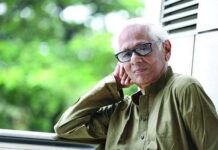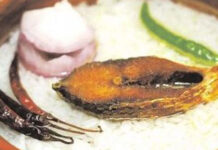Bangladesh has influenced the heritage and cultural traditions of Europe much more than it gets credit for
In Britain, the phrase “going for an Indian” would not conjure up visions of some kind of racial attack. Rather, it would describe what has become Britain’s favourite eating out activity.
The trouble is of course, that it is a fundamentally incorrect description of the intended activity since over 75% of the restaurants described are in fact owned, operated and where possible, staffed by Bangladeshis.
This describes a heritage in which Britons, as well as countless other nationals, live in the past rather than present. When people in Europe and other parts of the developed world refer to an “Indian” influence on their heritage and cultural traditions, especially the cuisine of their nations, it is most commonly the influence of the lands that were historically the lands of the famous Ganges and Brahmaputra delta to which they are actually referring.
The India that is recognised in Britain as having had such a significant influence on the economy, culture, heritage and traditions of Victorian Britain was, above all, an India that was Bengali. Even components of Bengal such as the prehistoric land of Gangaridai, so familiar to Greek and Romans, also played a part.
More than a matter of semantics or academic accuracy, it lies at the very foundation of the economic and social prospects for what remains one of the world’s less developed nations.
The epicentre of this Bengali heritage was one that grew and matured in the lands of the delta of three great Asian rivers that linked the whole of the Ganges basin, the Himalayan kingdoms, including the Tibetan Empire, Sikkim and Bhutan, China, Burma, and the coastal regions and islands of South east Asia, those of the Ganges itself, the Brahmaputra and Meghna.
There is documentary, literary and archaeological evidence that identifies these lands as one of the world’s earliest and greatest international trading centres, certainly from the middle of the first millennium BCE, when Alexander the Great of Macedonia sought to conquer what was then known to the world as Gangaridai.
Reading the classic historians, from Megasthenes (almost contemporary with Alexander) to Plutarch and beyond, leaves little doubt that these lands were in Alexander the Great’s plans for his next conquest – for the wealth that such trading centres invariably have.
If anyone has ever wondered quite why the European nation which, from the 15th century onwards, chose to focus their activities not primarily on the more accessible east coast, but in fact in this most inaccessible (to them) corner of the great Indian subcontinent, they will find their answer in the slow but steady revelations by researchers of trade history archaeology, ethno-archaeology, and even religion and culture.
The Ganges delta was, unquestionably, a great crossroads of trade, including, perhaps, the earliest of the trade routes that became known in the late 19th century as “Silk Roads.”
It is no accident that the British took an early interest in these lands, even if it was more accident than design that put control of them into their hands.
As the foundation of the Raj and an empire “upon which the sun never set,” the myriad British stately homes built with East India Company dividends and personal fortunes accumulated in these lands. From palaces and other cultural influences to the great establishments of the industrial revolution itself, it was, above all, wealth accumulated in the delta that financed them.
Even the great fictional adventurer Robinson Crusoe was described by his creator, Daniel Defoe, as being “well satisfied with trade in all the ports in which it was free to trade,” from his last great adventure – trading in opium and diamonds from his base in Bengal.
But if the Europeans, particularly the British, left their influence – linguistic, administrative and architectural – in these lands that are now Bangladesh, there is no doubt that the people, culture and land also, in turn, influenced the British.
The linguistic details that linger in the English language are only a part of that influence. In the palaces and stately homes constructed in Britain with wealth garnered in these lands of Bangladesh, from trade and agricultural products, the influences of “oriental” architecture with its domes and distinctive arch and window shapes are also common.
Not least in that supreme example is the Brighton Pavilion, with its distinctive Muslim style, built around 1787 for Prince George, who subsequently became King George IV. Neither, one suspects given the history of the unique and very close relationship between China and the lands of the delta along what we now know as the South West Silk Road, is the extensive chinoiserie evident in the interior detail and furnishing.
Such architectural details are to be commonly found in buildings, furnishings and fittings of so many of the mansions built in the 18th and 19th centuries.
In the 1857 war for Indian Independence the lands of the delta were nearly immune from conflict because of a rising middle class, thriving trade and industry and increasing affluence.
Perhaps better-established relationships from a longer period of settlement also contributed to this, as they did to the foundation of those mutual influences. It’s also manifested in the almost tidal surge of people from Bengal seeking an education in Britain from the early 19th century until today.
Having been the original British administrative base in India and the closest to the riches of a Bengal where they were largely reliant on Armenian merchants to undertake their trade, until the acquisition of full revenue gathering rights in 1765, there is no doubting the vital importance of both those developments and the wealth generated through them in laying the foundations for the eventual annexation of the rest of the sub continent and surrounding territories.
It is no accident therefore, that, even today, when a Brit refers to “eating an Indian,” his or her implication is not literal but a hangover from a century or so ago. Also significant are English words like jute, palanquin and indigo, of Bangla origin, and those of Sanskrit derivation, such as Buddha, nirvana, yoga (not insignificant considering the lands of the delta as the likely birthplace of Buddhism) and Aryan extraction (which significantly, in the light of the trading history, shares a root in Latin and Greek, as do many other words, including sapphire, which also embraces French roots).
The list is, in fact, considerable and this linguistic heritage long predates the 16th century, when Europeans finally returned to the subcontinent for trade after the collapse of the Roman Empire.
Somehow, somewhere in the 20th century, the lands that were the essential India to the British, and to the world – those that were in Bengal but especially those of east Bengal, which is now the heart of contemporary Bangladesh – have remained in the British psyche as India.
The extraordinary, rich history that was uniquely the lands of Bangladesh – as one of the world’s earliest centres of trade – was so cosmopolitan that the Roman historian of the 3rd century, Dionysius Periegetes, described the people of Gangaridai as “dedicated followers of Bacchus.” This was surely one of the world’s earliest description of the social phenomenon we now call globalisation – cross-cultural exchanges.
No one since has been brave enough to examine such cross-cultural interchange closely enough, neglecting, even, the cultural interchange of cuisine. What the world so often calls “Indian” very often should be more accurately called “Bangladeshi.”
At the risk of sounding more than a touch paranoid, the apparent and careful exclusion of Bangladesh, with its 160m people, from such online encyclopaedic commentaries on cultural and linguistic origins as those of the all-important Sanskrit language, suggests that the unawareness of Bangladesh and its central role in the development of things “Indian” means that others in the subcontinent are more aware of the potential economic and social significance of such a realisation.
Wikipedia’s discourse, for example, on the significance of the influence of Sanskrit lists India, Pakistan, Sri Lanka and Nepal as the countries most involved. And it is, of course, widely recognised that Indian technicians and academics are masters of Wikipedia on the subject of the sub continent.
Whilst recognising that the history of the Harappan civilisation may yet be revealed as highly significant in the foundations of true Indian traditions and culture, it would be unwise to ignore the fact that bibliographical tradition as well as the archaeological, underline the wealth and cultural diversity in the lands of the delta as a centre for both affluence and diversity to spawn the evolution of Hindu traditions (as it also did both Jain and Buddhist traditions) and with them cultural development, such as written languages like Sanskrit. And the fact that this brings any cultural historian back to the lands of the delta seems inescapable.
Imagine what such an appreciation could do for inbound tourism in Bangladesh, probably the greatest unrealised potential for economic and social development in the country!
Source: DhakaTribune











There is nothing called Indian cuisine, what the world knows as Indian food is nothing but Mogul dishes (originally Turkish) with spices from various parts of India. And to state precisely, it is Indian Muslims’ food. For example, beef cooked by a Punjabi Muslim differers slightly when the same beef is cooked by a Bengali Muslim. Similarly, the question of Bengali heritage also is not the same in Bengal. Heritage develops with culture and as Bengali Hindu and Muslim culture differs (due to religion) from each other, their food also differs greatly. I am not trying to spread communalism but a neutral individual can see clearly what I mean. India was never one country and it would never be. Similarly, EU is a union but not an identical entity. The food houses in UK is owned and staffed mostly by the Bangladeshi people and thus, we can call it Muslim Bangladesh food developed with Mogul tradition.
I am glad that Mr. Hussain has made this apt and inescapable distinction between Muslim l and Hindu Bengali cooking. As he correctly points there is nothing communal about it. Differences in religion, rituals and habits have brought about this distinction. However, this is also true that while there are marked differences between the cultures of these two Bengali communities, there are also aspects where they converge and these are most visible in food.
There is no denying that in Bengal, there are what we know as Muslim Bengali food (biriyani, parathas of various kinds etc.) and Bengali Hindu food – labra, khichuri etc., to name few) that are markedly different from one another.
Although some of the so-called “Hindu” dishes are also popular with Muslims, preparation style and use of spices are different. Muslims tend to use more oil, ghee etc. whereas Hindus make their sauce rather light and yet tasty.
Also when it comes to Khichuri, Muslims specialize more in Bhuna Khichuri which is an invention of Mighal Emperor, Shajahan and Hindus more in “letka”..
For a more insightful understanding of Muslim, Hindu Bengali food I recommend Chtrita Banerjee’s “Bengali Cooking: Seasons and Festivals”.
Chitrita is from Kolkata but was once married to a Bangladeshi and lived in Dhaka over a long period where she was able to articulate the culinary distinctions of these two communities of Bengal most aptly and indeed in a very educated manner.